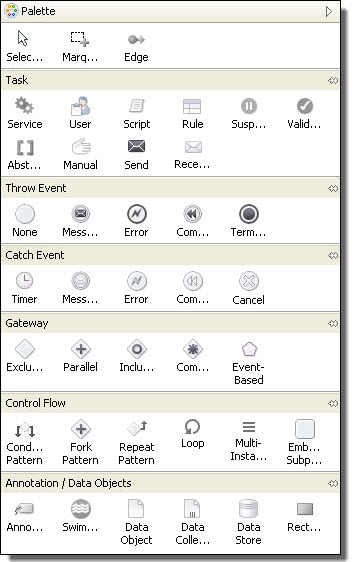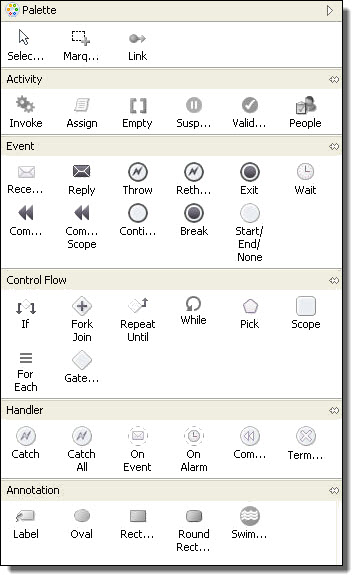BPMN  | BPEL  |
BPMN  | BPEL  |
Edges and selections | An edge connects two activities to make them run in sequence. Use the other selection tools to select a set of items on the canvas. |
Task | Basic process activities to build a process. For example, select a service task to represent a Web service endpoint. |
Throw Event | Events that have an impact (a result), such as a reply, invoke, throw, rethrow, compensate, exit, and break. These are outbound events. |
Catch Event | Events caused by a trigger, including wait, receive, and scope handlers, which include fault, termination, event, and compensation. These are inbound events. |
Gateway | Controls the divergence and convergence of sequence flows, including branching, forking, merging, and joining of paths. Includes the BPEL pick activity as an event-based gateway. |
Control Flow | Containers to structure a group of activities. |
Annotation/Data Objects | Add labels, shapes, and swimlanes to the canvas. They are ignored in the XML code, but they print. You can anchor a label to an activity. |
Custom | Save any activity or set of activities from a BPEL drawing as a custom activity. You can reuse the custom activity in other BPEL drawings. By default, the custom palette is hidden when empty. For details, see Creating a Custom Activity. |
Links and selections | Use a link to connect two activities to make them run in sequence. Use the other selection tools to select a set of items on the canvas. |
Activity | Basic process activities to build a process. For example, select an invoke to represent a Web service endpoint. |
Event | Select an activity that triggers an event, such as a receive, to start a process. |
Control Flow | Select a container or gateway to structure a group of activities. |
Handlers | Select a fault or event handler for a scope. |
Annotation | Add labels, shapes, and swimlanes to the canvas. They are ignored in the XML code, but they print. You can anchor a label to an activity. |
Custom | Save any activity or set of activities from a BPEL drawing as a custom activity. You can reuse the custom activity in other BPEL drawings. By default, the custom palette is hidden when empty. For details, see Creating a Custom Activity. |